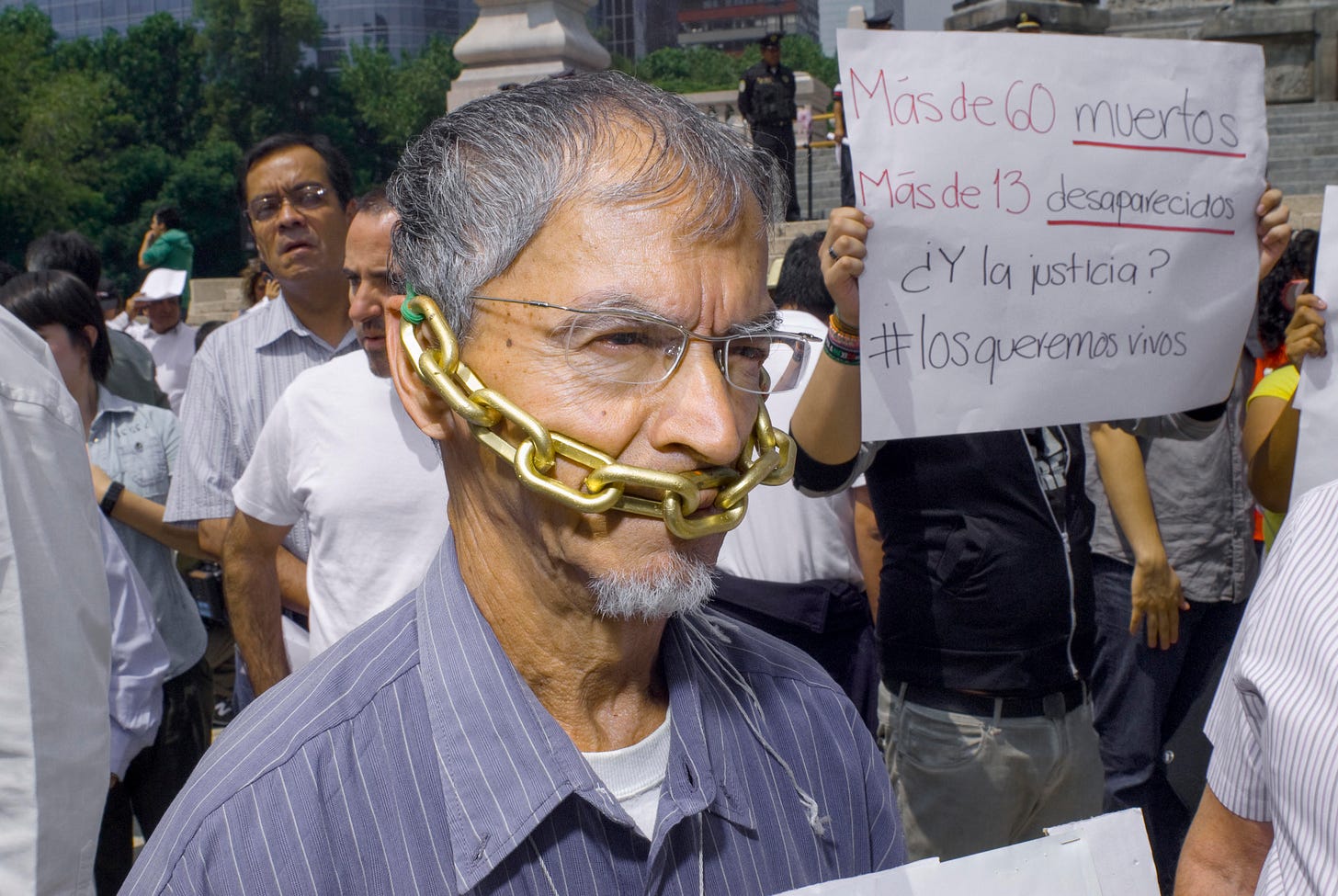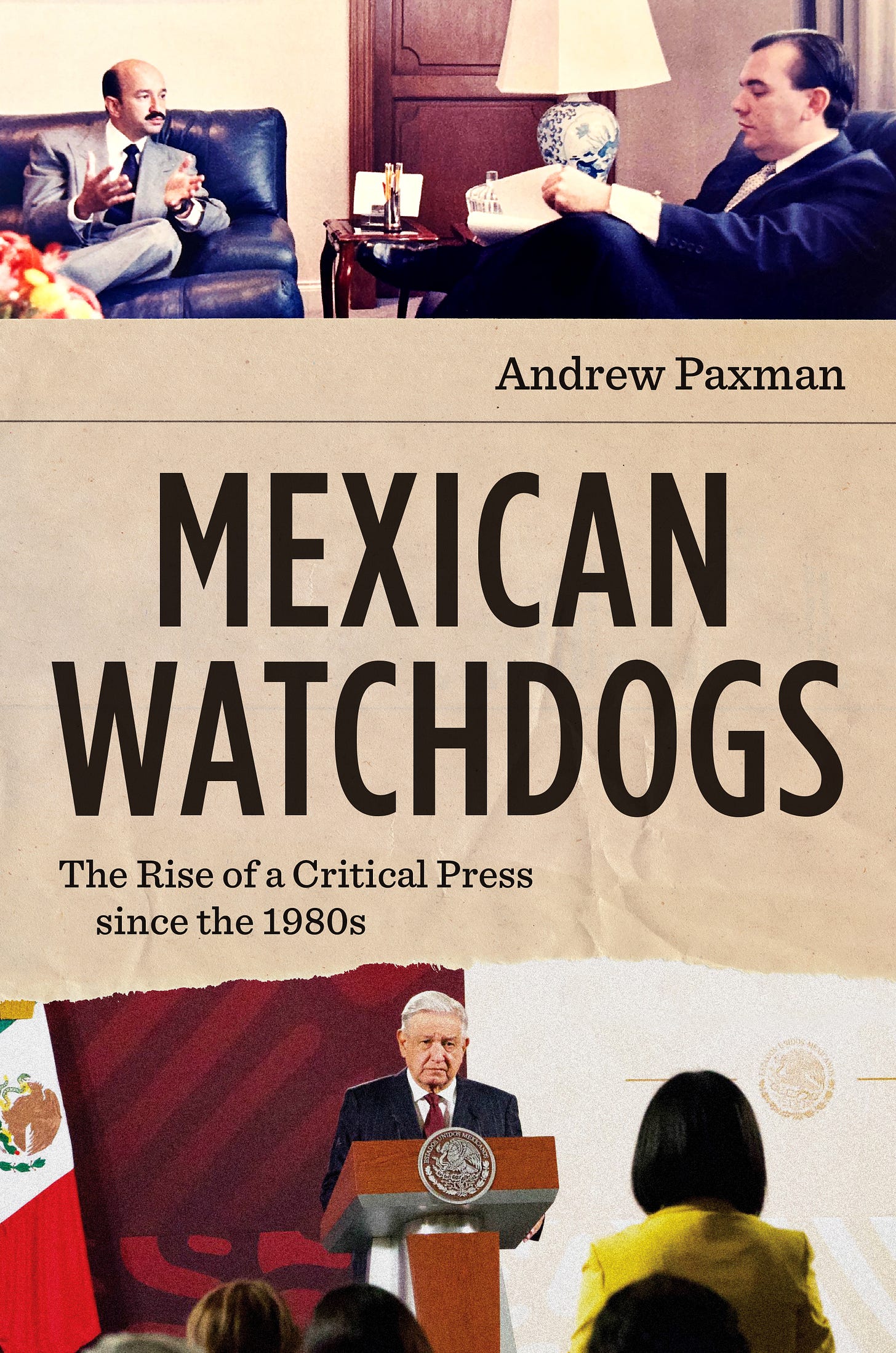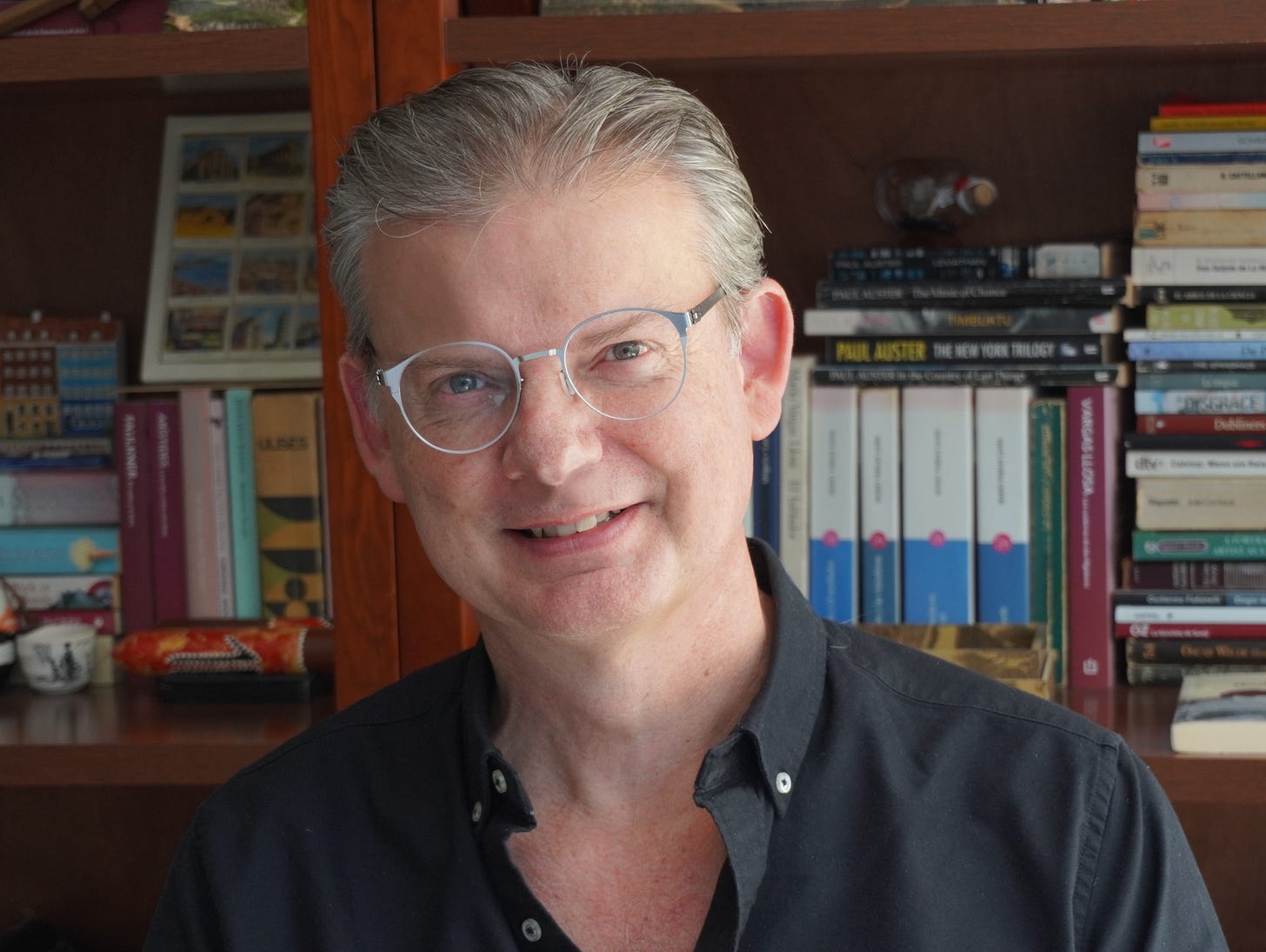Mexican Watchdogs (Journalists) Under Fire
An excerpt from Andrew Paxman's new book "Mexican Watchdogs" out today
The number is both mind-blowing and sickening: more than 150 journalists have been murdered in Mexico since 2000, making it one of the most dangerous places to ply the trade on the planet. The sheer scale of the tragedy can make you lose sight of how each victim was an individual with their own story, career and loved ones who still feel the pain.
Yet despite this systematic attack, the Mexican press has been surprisingly resilient in covering the narco bloodbath, political corruption and public disorder. And that is an inspiring tale of heroes.
Andrew Paxman is an esteemed historian, former journalist and fellow Brit living in Mexico who has penned a remarkable new book on the Mexican press, which comes out today. Mexican Watchdogs: The Rise of a Critical Press since the 1980s tells the complex story of how a feisty journalism emerged amid the demise of the one-party state at the end of the twentieth century. The violence (and narco violence) is only part of this chronology, but you can’t tell the story without it, and this excerpt I’m proud to publish at CrashOut looks at how Mexico became so dangerous for the press. You can buy Mexican Watchdogs, at Amazon here or from Bookshop.org here. - IG
Ernesto Aroche lay face down on the floor while three men with guns ransacked the office of the news site he had founded. He was overwhelmed with anger and frustration. He thought, “What can I do? What can I do?”
Lying near him, Mely Arellano, his partner in life and work, worried how Ernesto might react. They had been friends for a dozen years and colleagues at several of Puebla’s newspapers. She knew he did not scare easily and feared he might do something rash.
After the burglars left, their arms full of loot, Aroche sprang up and chased them out onto the street. A colleague ran after him and restrained him. But the burglars were anyway too quick, a waiting car speeding them into the December dusk.
The three journalists took stock of the damage to their operation, the small and bold online newsmagazine LadoB (B side). The thieves had taken six laptops, several cell phones, backpacks, and a haul of company documents. They had been quick. They had yelled at the journalists to “get down on the fucking floor!” After that they had not spoken.
Having given their statements to the police and visited the district attorney’s office, Aroche convened his editors and reporters at the home of a friend and they all debated what had happened. The professionalism of the thieves suggested off-duty cops. LadoB had only launched five months before, in July 2011. Whom had it offended?
The likeliest suspect, they came to agree, was the state’s secretary for public security, Ardelio Vargas. A renowned hard-liner, Vargas was a Puebla native who had risen in national law enforcement, first in the army, then in the secret service, and finally in the federal police. In the last capacity, he gained infamy for involvement in the bloody repression of 2006 at Atenco in the State of México, where locals were protesting plans for a new Mexico City airport. Hundreds had been arrested, two killed, and many women allegedly abused or raped by police. Then, in early 2011, Vargas was called back to Puebla by the hard-line new governor, Rafael Moreno Valle Rosas.
As chief of local law enforcement, Vargas lived up to his reputation for intolerance of social protest. His state police harassed and arrested marchers, made illegal searches of homes, and allegedly tortured detainees—in one case with electric shocks to the testicles. LadoB, founded on principles of public service, covered it all. “Vargas Accused of Being ‘the Greatest Repressor That Puebla Has Had,’” ran one headline, quoting a complaint from thirty-five civic organizations. A week before the burglary, the site ran a mocking cartoon of Vargas as a tubby version of Kalimán, a turbaned superhero of 1970s comics, known for his detective skills and great strength. A police-beat reporter told them that the picture bothered Vargas a lot. Nonetheless, Aroche and his team would never succeed in conclusively linking the burglary to Vargas, and the perpetrators would never be traced.
“The only thing we cannot do is give up, because then they win,” Aroche told his colleagues on the night of the incident.
The immediate dilemma was that the theft had left them with a single desktop computer. LadoB published nothing for a month. But thanks to a fundraiser, the team acquired new laptops and returned to action in January. With a business model that did not rely on state largesse, their dedication to watchdog journalism remained. Announced the first headline, “A Year of Public Insecurity with Moreno Valle and Ardelio Vargas.” Murder, kidnapping, theft, and rape had all risen in Puebla during 2011. Moreover, in Moreno Valle, LadoB had one of Mexico’s most despotic governors to hold to account.
*****
Luis Carlos Santiago died from bullets to the head at two in the afternoon on Independence Day. He was interning as a photojournalist. He was twenty-one.
That September 16, 2010, someone had been murdered at a shopping center, and Santiago accompanied a staff photographer, Carlos Manuel Sánchez, to take photos of the crime scene. Although the mall was very close to the offices of their employer, El Diario de Juárez, they arrived by car, and it was in the parking lot that they were shot at by several young men in another car. Santiago was at the wheel and he crashed the car as he died. Sánchez, hit several times, scrambled out and ran. One of the attackers gave chase, but after firing twice and missing he gave up.
Were Santiago and Sánchez shot at to stop them reporting the earlier murder? (Unlikely, as hit jobs in public places are usually designed to send a message.) Was the shooting of Santiago, as initial reports from local and federal authorities would have it, related to his “personal activities”? Or had the two young men been followed to the mall and targeted because they were employees of El Diario, the leading daily in the state of Chihuahua, which had a reputation for refusing to be silenced by threats?
The personnel of El Diario had endured the nightmare of a murdered colleague once too often. Back in 1991, their columnist Víctor Manuel Oropeza had been stabbed to death in his doctor’s office, probably on the orders of a corrupt police commander, although the crime was never solved. In October 2008, another columnist, David García Monroy, numbered among a dozen killed when hooded gunmen burst into the bar where he was drinking and opened fire with machine guns; this crime too was never solved, but García Monroy’s death looked like the random consequence of an unhinged narco mission. Only a month later, one of the paper’s top writers, crime reporter Armando “El Choco” Rodríguez, died one morning outside his home, at the wheel of his car. As his eight-year-old daughter sat watching, a hitman walked up and fired ten times through the driver’s window.
Of the two gangsters eventually named in a federal bulletin as responsible for Rodríguez’s murder, El Diario news editor Rocío Gallegos found that one had died in jail three months earlier and the other had complained to the National Human Rights Commission that he had “confessed” under torture. After another two years, federal prosecutors admitted that agents dispatched to Juárez were unable to find people willing to speak. Finally, in 2016, eight years after El Choco’s murder, the alleged gunman (and possible torture victim) was sentenced to thirty years. The mastermind remained free—a situation unlikely to change. Just after the conviction, freelancer Témoris Grecko visited El Diario to research the murder for a book about the perils of Mexican journalism, Killing the Story. A reporter who had worked with Rodríguez told him, “Most of the people who participated in the investigation are dead.” The first federal investigator appointed to the case, his successor, agents and experts from the state attorney’s office—for one reason or another, they had all been killed.
In 2010, the year of Luis Carlos Santiago’s death, Juárez recorded more than 3,000 murders, twice the total of two years earlier. This cemented its per capita ranking as the most homicidal city on earth. The slaughter raised the siege mentality and daily anxiety of functionaries, law enforcement agents, and journalists alike. Two days after Santiago was murdered, several narcomantas were hung from footbridges across Juárez, directed at the press. To the editors of El Diario, this was the final straw. They wrote an anguished front-page editorial. Addressed to the “organizations” that were disputing the city’s plaza (a narco term for exclusive territory), it amounted to a withering critique of federal and local governments: “You are, at present, the de facto authorities in this city because the legally instituted powers have not been able to keep our colleagues from dying.” It went on, “We don’t want any more dead. We don’t want any more injured nor any more intimidation. It’s impossible to do our jobs in these conditions. Tell us, therefore, what you expect from us as a media outlet.”
What struck observers most, spurring coverage around the country and abroad, was the editorial’s desperate headline, more a cri de coeur than a literal question: “What do you want from us?”
The complexity of El Diario’s plight explained the variety of responses. Toronto’s Globe and Mail, supportive of President Felipe Calderón’s policies, sniffed that “negotiating with criminal organizations is not an option.” The New York Times, by contrast, empathized: “El Diario has shown great courage in the past.” Sympathy among other Mexican papers based in high-violence regions led to similar editorials and opinion pieces. A year later, El Diario (along with Culiacán weekly Río Doce) was named a corecipient of the highest accolade in Latin American journalism, the Moors Cabot Prize from the Columbia University School of Journalism. As for Los Pinos, already upset at El Diario’s criticisms of Joint Operation Chihuahua, a scheme to combat the crime syndicates with hordes of soldiers and federal police, it restricted the paper’s access to federal advertising in both 2011 and 2012.
El Diario insisted in its editorial that asking what criminals wanted of it was “not a surrender.” But how could the paper’s editors and writers not now tread more carefully? Like all print media, the paper had also to deal with declining revenues. And like many in the provinces, it had to contend with often unsympathetic governors and mayors. Over subsequent years, observers (including Grecko) noted a decline in the paper’s independence and journalistic standards. In 2013, news editor Gallegos was promoted to editor in chief, but in early 2018 she was demoted, as the paper’s owners saw her critical journalism standing in the way of better advertising contracts from the state government. So she quit, asserting her belief that “journalism should neither be close to nor in the service of the authorities.” She then founded the independent news site La Verdad (The Truth).
*****
With the new century—and, ironically, the consolidation of electoral democracy— a whole series of factors converged to make reporting more dangerous. In the first decade, 65 journalists were murdered or disappeared. In the 2010s, the total reached 101.
The resurgence of state governors as feudal lords was the first and perhaps the most important cause. Presidents from Emilio Portes Gil in 1929–30 to Carlos Salinas de Gortari in the 1990s had had little difficulty in ousting inept, ultracorrupt, or homicidal governors, due in part to a constitutional clause that allowed the Senate to dissolve any state government. Since Los Pinos controlled the Senate, the matter did not have to go to a vote; the president would snap his fingers and the governor would have no choice but to quit, usually requesting the face-saving device of “indefinite leave.” But the senatorial mechanism ceased to function in 2000, for the victorious PAN failed to obtain a majority of senators. Unleashed politically, governors also found themselves empowered economically, thanks to a 1998 fiscal reform that greatly increased their budgets and their discretionary spending. These changes fueled a common gubernatorial culture of autocracy, arrogance, and acquisitiveness.
Many governors thus set a tone for lax adherence to rule of law and contempt for independent journalism, which permeated their fiefs. They did so in part through their rhetoric, publicly shunning or deriding critical media. They also did so through their lavish spending on advertising, so as to co-opt the press—rather as Calderón was doing at the federal level—and to withdraw it when they did not like what they read. Moreno Valle of Puebla experimented with a so-called tripack: Ad buys from the state’s three biggest spenders, the state university, Puebla’s city hall, and the state government, were disbursed only to friendly media. Once Vicente Fox had set the precedent of using a governorship as a launchpad for a run at the presidency, a number of ambitious governors became more than usually image conscious. Often the amount of their outlays was covered up. When nongovernmental organizations Article 19 and Fundar asked every state government in 2011 to account for its ad spend over the previous five years, only two states gave a complete accounting, nineteen submitted partial figures, and eleven did not answer.
Governors and their security chiefs also faced temptation to profit from protecting drug traffickers. Such rackets had ancient origins—dating from the revolution in the border states—but they spread southward as of the mid-1980s when the Colombian cartels switched their US-bound cocaine routes from the Caribbean to Mexico. Diversification of those routes within Mexico, or along its coast, meant that by 2000 many states were involved. Increased profits from the trade gave the crime syndicates the upper hand in their relations with state agents: The cash they wielded was simply too much for police, mayors, judges, and even some generals to resist. In turn, governors had a decision to make, a variation on the old offer of plata o plomo (silver or lead—i.e., a cash bribe or a bullet): They could accept payment for aiding the traffickers, risk a surge in local violence if they tried to stop them, or simply look the other way. A number chose the first option, as evidenced by how the government, sometimes under US duress, eventually went after them. By 2017, six former governors had been formally charged with narco links.
None of this is to say that governors necessarily ordered journalists killed. But it is likely that, as governors let narco influence spread in their states, lower-level officials who were threatened with exposure of their complicity felt free to silence their critics. After all, the governor had their backs, through control of the state’s police and judiciary and through steering of the narrative about the victim. One result of these networks of protection was something close to across-the-board impunity, which in turn gave corrupt officials and narcos alike the confidence to carry on killing. This is what happened most notoriously in Veracruz under Duarte (2010–16). As media historian Celia del Palacio demonstrates in her study of the Duarte-era press, aptly titled To Shut Up or Die in Veracruz, the governor excelled at crushing freedom of speech. In total, twenty media workers were killed and five disappeared. To date, the mastermind of the hit has been jailed in just one of those cases, making for an impunity rate of 96 percent.
In 2015 a federal prosecutor’s office conducted its own study of journalist killings and estimated that 40 percent owed to agents of the state. In Veracruz, the proportion was 80 percent. But such figures may suggest a simplistic apportioning of blame. After all, another upshot of the protection networks was the difficulty in telling the agency of narcos from that of corrupt politicians. When murders occurred, to whom could local journalists point with any certainty as the guilty party? What about murders of which there was more than one mastermind, such as a crime capo and political protector making the call together?
Adela Navarro of Zeta once defined the trajectory of her paper thus: In the 1980s, its focus was on political corruption; in the 1990s, it was on drug trafficking; and from 2000 it was on the mixing of those two evils. She referred to the phenomenon as narcopolítica—that is, narcopolitics.
Historian and journalist Andrew Paxman
Top photo by Kieth Dannemiller, courtesy.






I'm constantly amazed at the bravery of journalists in Mexico. In the USA, we have to search hard to find the real news, because our corporate owned news organizations are essentially stenographers regurgitating press releases. Meanwhile in Mexico, even with the dangers they face, many Mexican journalists continue to investigate and publish the truth as they see it. The state probably looks at USA corporate media with envy and that's probably part of the reason they do very little to protect journalists.
Ioan,
Thank you for your courage reporting truth to power with amazing historical evidence. We are in this together. No Kings. Peace.
Christopher and family